It’s time for the last of our famed four Roman pastas. This time around, it’s all’amatriciana, i.e., in the style the Amatricians. Amatrice, where this pasta supposedly originated as a peasant dish is about 100 miles northeast of Rome. The dish, like the others we’ve been exploring, is based on that original gricia, with cured pork and cheese being the core ingredients of the “sauce”. Over time, gricia added in pepper; and then cacio e pepe eliminated the pork, probably for economic reasons; amatriciana added in tomatoes and subbed in dried, smoked chilies for the black pepper, sometime in the 17th century most likely (as tomatoes first arrived in Italy in 1596, and it took some time for their acceptance to spread); and carbonara added egg to the gricia, probably within the last century.
The first recorded mention of the dish is in April 1816, when a famed chef, Franceso Leonardi, served it in Pope Pius VII’s court at a banquet hosting the Austrian emperor Francis I, fancied up – one of those “let’s serve peasant food to rich people and see if we can get away with it” moments. The dish was then introduced to the Roman populace at a local trattoria, a tavern, called L’Amatriciana. Over time, the dish became popular in other trattorias, and simply because of the fame of Rome, became known as one of the four pastas of the city. Amatrice is, after all, a fairly small town of only about 2500 people, mostly known these days because it was the epicenter of a massive earthquake in 2009 that left 65,000 people in the surrounding area homeless, and killed 300 and some.
By now in this series, you recognize the guanciale and grated pecorino romano. In lieu of coarse ground black pepper, we use dried, lightly smoked chili flakes. Some people use both, some people stick with black pepper, I learned it with just chili flakes. There’s often white wine added as well, but that’s not universal and some would disagree. As to the tomatoes, there are those who use peeled, crushed plum tomatoes and those who use the far more crushed passata, which is the way I learned it. Flavor-wise not really any difference, it’s more visual. Garlic? Not traditional, but, some people use it – I’ve made both, here we’re doing it without.
The pasta of choice for amatriciana is bucatini, a thicker extruded pasta with a hollow center. Ostensibly this is to allow the sauce to get inside, but unless your sauce is so thin that it’s like water, that ain’t happening, other than maybe a little at the ends. It’s more textural – you get that bite of a thicker pasta, but not so thick and chewy that it’s a workout like pici, umbricelli, or strozzapretti. It’s somewhere between 2-3 times the diameter of spaghetti, more like spaghettoni.
It takes longer to cook, so I get it in the water before I start in on cooking the other ingredients. It probably gets a solid ten minutes before it’s going to head to the skillet with the sauce.
Render the guanciale over low heat – takes about 6-7 minutes.
When it’s nicely golden, add the chili flakes and toast them off in the rendered fat for about 30 seconds – you don’t want them to burn. This isn’t intended to by a really spicy dish, so it’s not a lot of chili flakes – for two portions I use somewhere between ½-1 teaspoon. If you like spicy, go for it and add more, or even use fresh chilies.
Deglaze with the white wine, getting all those crispy bits into it. Cook it down until it’s mostly absorbed and/or evaporated, but has flavored that fat.
Add a ladle of the pasta water and whisk to emulsify.
Add the tomato passata or crushed tomatoes and incorporate well. Give it about two minutes to thicken up.
And that should be just about perfect timing for the pasta to be ready to finish cooking in the sauce. Add the pasta to the sauce along with another ladle or two of pasta water (add one, and then another only if needed). Increase the heat, stirring and tossing, until the pasta is cooked through…
…and the sauce clings to it.
We’ve got our cheese “cream” from melting and stirring it with a couple of tablespoons of hot pasta water. Stir and toss that into the skillet to completely coat the pasta.
And, serve.
Next time, we’re back Campania, sort of, and a look at… Puttanesca.
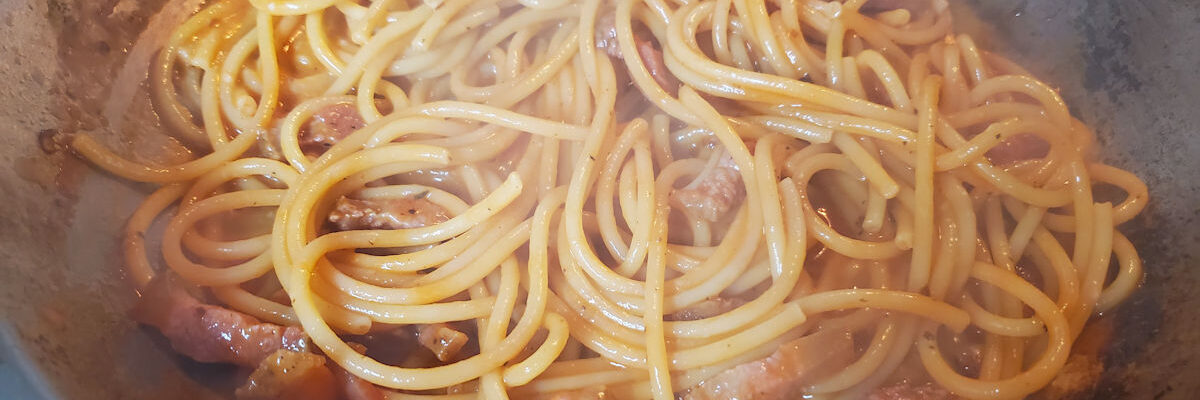
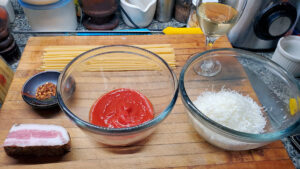
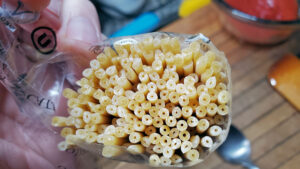
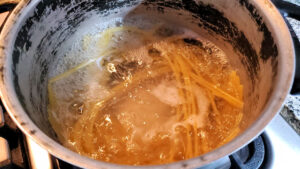
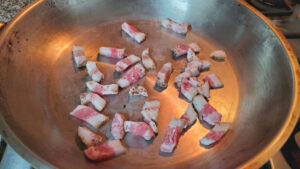
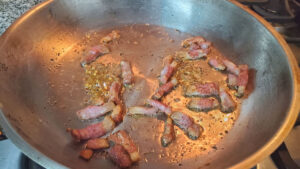
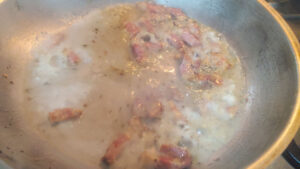
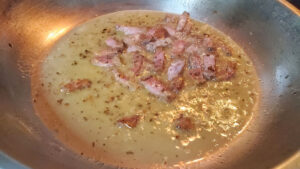
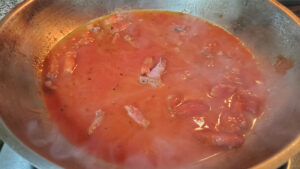
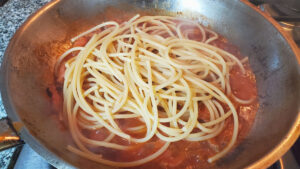
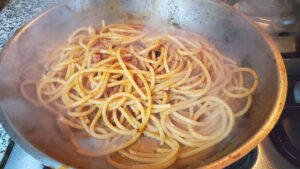
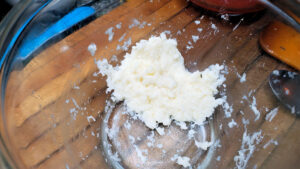
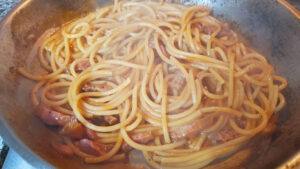
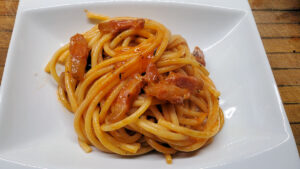
[…] pasta dish recipes. I thought we’d start with Rigatoni all’Amatriciana. You can see how to make the sauce here. Although most classicaly made with bucatini, it’s also common with rigatoni, and, it was […]
[…] Those of you who’ve been with me awhile may well remember my explorations of the four famed pastas of Rome, and their family tree connections. A quick reference back – gricia, cacio e pepe, carbonara, amatriciana. […]